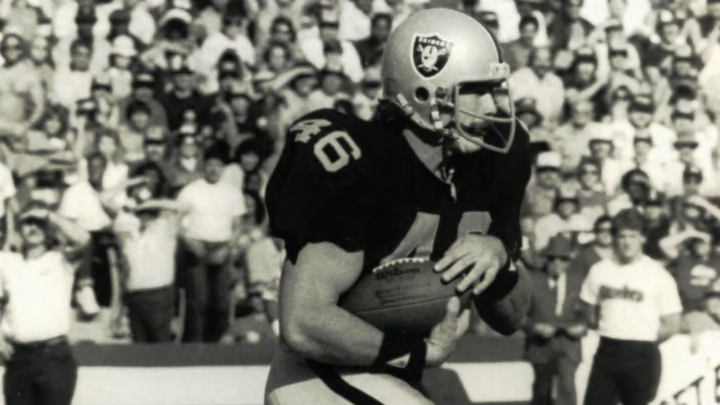The Case for Todd Christensen in the Hall of Fame, Pt. 1

Revered NFL writer and Pro Football Hall of Fame selection committee member Rick Gosselin once wrote in his case for legendary pass rusher Mark Gastineau, "The Hall of Fame bylaws state that all candidates must be judged strictly on their on-the-field merits."
Former Oakland/Los Angeles Raiders tight end Todd Christensen was one of the best of his generation. He set records. He was the first to the milestones he accomplished for the position.
Today, he might be referred to as a "trailblazer." Today, Christensen is not in the Pro Football Hall of Fame. He has never been a finalist, nor semi-finalist.
Unfortunately, the evolution of the game has passed by the tight ends of old. The tight ends of my generation, such as Travis Kelce and Rob Gronkowski, and the ones I grew up admiring like Antonio Gates, even Shannon Sharpe, all played in a vastly different league from the one Christensen participated in.
It was not a passing league like today. Tight ends had a much bigger (even primary), role as blockers. Defenses were less hand-cuffed by NFL rules. Yes, this was post-Mel Blount rule, but pass catchers had much more to contend with.
It is unfair, irresponsible even, to compare between eras. For example, the juxtaposition of Johnny Unitas to Dan Marino to Tom Brady does not measure up. And yet, every list of the greatest quarterbacks to play the game will inherently pit their careers, numbers, and achievements against one another.
I feel this should be addressed first in the case for Christensen. While Christensen should be judged against the tight ends of his time (and will be in this series), there are those that will wrongly compare him to modern tight ends with inflated numbers.
When compared to Gates, Gronkowski and Sharpe, Christensen's numbers will look pedestrian. They had far more yards, receptions and touchdowns. Christensen began at running back, bounced between the Dallas Cowboys and New York Giants, and didn't catch his first pass until the 1980 playoffs. It was a touchdown.
From 1980 to 1989, Christensen was a tight end. 137 games.
Gates played 236 games. Sharpe played 204 games. Gronkowski played 143 games, the closest to Christensen.
Gronkowski arguably has the best case of the three for the "greatest" to play the position.
Again, this is not to compare or attempt to put Christensen in the category of those three bona fide all-time tight ends. The difference in era is too great.
But where he stacks up with the "basketball-player" modern tight end is something that will be looked at, nonetheless.
The fact is that Christensen had four consecutive 80 reception seasons (the first player, at any position, to accomplish the feat).
Gates had just two 80 reception seasons in his career. Gronkowski had two. Sharpe had three.
Christensen set the then-record for receptions by a tight end in 1983, snagging a league-leading (any position) 92 passes. He broke his own record in 1986 with a league-leading 95 receptions. The first tight end to ever record a 90 reception season, and he did it twice. Gronkowski had just one 90 reception season, in 2011.
Sharpe and Gates failed to reach 90 receptions, though they came close.
None of those three tight ends ever led the league in receptions.
Gronkowski had four 1,000-yard seasons, just one more than Christensen's three. Christensen had one more 1,000-yard season than Gates' two. Gronkowski and Christensen both made four All-Pro teams.
It should be mentioned that Christensen never played with a Pro Bowl quarterback. Jim Plunkett, despite playing his best under Raiders head coach Tom Flores, was never selected. Neither was Marc Wilson.
Sharpe played the brunt of his career with a Hall of Fame quarterback in John Elway. Gronkowski played with arguably the best to ever do it, Brady. Even Gates had a future Hall-of-Fame quarterback in Drew Brees for three seasons before getting a new signal caller in Phillip Rivers, an eight-time Pro Bowler and 60,000-yard passer.
Also worth noting is that Christensen won two Super Bowl championships, in 1981 and 1984. As it stands right now, the only tight end in Canton with more rings is Sharpe with three. No other tight end enshrined has more than Christensen.
Only Mike Ditka and Raiders contemporary Dave Casper have Christensen tied. Where does that stand in a sport where "Winning isn't everything, it's the only thing"?
Again, comparing players that played night-and-day different games is futile. But for those short-sighted enough to do it, I give you the above paragraphs. Sharpe is credited as one of the great tight ends.
Gronkowski might have an argument for the "greatest" title and he is a sure-fire Hall-of-Fame inductee when he becomes eligible in 2027. Gates was a finalist in 2024 and will likely get in.
I am not saying Christensen was better than the aforementioned tight ends. There is no comparison. They happened into the right time for big numbers. Christensen did not, but still thrived.
They were judged for their merits on the field. So should Christensen. No recognition from Canton is absurd. The problem is that Christensen was overlooked among his own peers, too.
Ensure you follow on X (Twitter) @HondoCarpenter and IG @HondoSr and never miss another breaking news story again.
Please let us know your thoughts when you like our Facebook page WHEN YOU CLICK RIGHT HERE.
